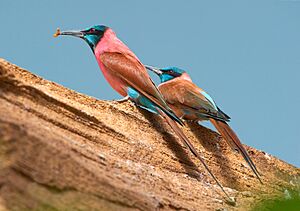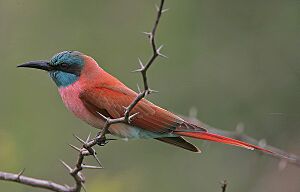Northern carmine bee-eater facts for kids
Quick facts for kids Northern carmine bee-eater |
|
|---|---|
 |
|
| Conservation status | |
| Scientific classification | |
| Genus: |
Merops
|
| Species: |
nubicus
|
The northern carmine bee-eater (Merops nubicus) is a beautiful, brightly colored bird. It belongs to the bee-eater family, called Meropidae. You can find these birds across northern tropical Africa. They live from Senegal in the west all the way to Somalia, Ethiopia, and Kenya in the east. This bird used to be considered the same species as the southern carmine bee-eater. However, the northern species has a blue throat, while the southern one has a carmine (red) throat.
Contents
About the Northern Carmine Bee-Eater's Name
The northern carmine bee-eater was officially named in 1788. A German scientist named Johann Friedrich Gmelin gave it the scientific name Merops nubicus. He put it in the same genus as other bee-eaters, called Merops.
How Scientists Classify This Bird
Scientists use a system called taxonomy to name and group living things. This helps us understand how different species are related. The northern carmine bee-eater is a "monotypic" species. This means it does not have any recognized subspecies or different types within its species.
What the Northern Carmine Bee-Eater Looks Like
Like other bee-eaters, this bird is slender and very colorful. Its body is mostly a deep red color, called carmine. Its head and throat are a greenish-blue. It also has a distinct black mask around its eyes.
Key Features of This Bird
The northern carmine bee-eater has bright red eyes. Its beak is black, pointed, and curves downwards. It also has long central tail feathers that stand out.
Differences Between Male, Female, and Young Birds
Male and female northern carmine bee-eaters look very similar. Young birds, called juveniles, are a bit different. They do not have the long central tail feathers that adults have. Their mantle (back), chest, belly, and flanks (sides) are a pinkish-brown color.
The Bird's Call
When flying, this bird makes a deep, throaty tunk sound. When it is sitting on a branch, it makes a series of rik notes.
Where Northern Carmine Bee-Eaters Live
This bird is native to many countries in Africa. You can find it in Benin, Burkina Faso, Cameroon, the Central African Republic, Chad, and the Democratic Republic of the Congo. It also lives in Côte d'Ivoire, Eritrea, Ethiopia, Gambia, Ghana, Guinea, and Guinea-Bissau. Other countries include Kenya, Liberia, Mali, Mauritania, Niger, Nigeria, Senegal, Sierra Leone, Somalia, Sudan, Tanzania, Togo, and Uganda. Sometimes, it might visit Burundi as a vagrant (a bird found outside its usual range).
Northern Carmine Bee-Eater Behavior
Reproduction and Nesting Habits
Northern carmine bee-eaters nest in large groups called colonies. They usually choose cliffs, often near river banks, to build their homes. They use their strong bills to dig long tunnels into the cliff. These tunnels can be eight feet or more in length.
Some colonies might have only a few nests, while others can have hundreds of breeding birds. The birds might use the same nesting site for several years. Then, the whole colony might move to a new location. Inside occupied nests, you can find black bits of insect remains. The nests also have a strong smell of ammonia. Female birds usually lay three to five eggs in each clutch.
What Northern Carmine Bee-Eaters Eat
The diet of these birds is mostly made up of bees. They also eat other flying insects. These can include flying ants, grasshoppers, and locusts.
How They Hunt for Food
Bee-eaters have a clever way of hunting. They sit on a perch, like a branch, and watch for flying insects. Once they spot an insect, they quickly fly out to snatch it from the air using their beaks. After catching their meal, they fly back to their perch to eat it.



